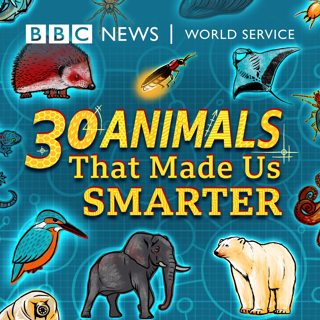
Albatross and drone
Imagine a drone that can fly like the Wandering Albatross. The huge bird harnesses power from the wind and sun and glides over the sea. It is extraordinary. And an engineer has designed a robotic glider that can also ride the wind, while surfing the waves like a sailboat. With Patrick Aryee. See all our animations so far: www.bbcworldservice.com/30animals #30animals
24 Kesä 201914min

Stenocara beetle and water collector
It performs headstands in a desert; now this beetle is teaching us how to collect water. The Stenocara beetle survives in one of the most arid places in the world – the Namib Desert in southern Africa. Scientists have been studying its wings and back. With Patrick Aryee. See our Stenocara beetle animation: www.bbcworldservice.com/30animals #30Animals
17 Kesä 201912min

Sea otter and wetsuit
Want a warm and waterproof wetsuit? Then take a look at how the sea otter does it! It’s all down to air-trapping hairs. Ideally, surfers want something that is flexible and easy to wear, which sheds water as quickly as possible when you are out of the sea and will keep you warm when you are in it. With Patrick Aryee. www.bbcworldservice.com/30animals #30Animals
10 Kesä 201913min

Desert spider and Mars robot
The cartwheeling spider acrobat that could help us explore Mars. This is no ordinary spider and it has led to an extraordinary robot design, perfect for space exploration. With Patrick Aryee. www.bbcworldservice.com/30animals #30Animals The audio for this podcast was updated on 7th June 2019.
3 Kesä 201914min

Cod and antifreeze
Fish living in sub-zero waters are inspiring ways to de-ice planes and store ice cream. Arctic and Atlantic cod and also snow fleas are able to live at temperatures which would normally freeze human blood. We are learning from them - new methods are now being developed that could even prolong the viability of human organs which have to be transported over vast distances. With Patrick Aryee.
27 Touko 201914min

Termite and ventilation system
A building which heats and cools itself? How was that possible? Termites had the answer. The insects circulate air around their homes or mounds and regulate the temperature inside. They inspired an architect called Mick Pearce, who was designing the heating and ventilation system for a large office and retail building in Harare. With Patrick Aryee. www.bbcworldservice.com/30animals #30Animals
20 Touko 201916min

Mussel and plywood
How a trip to the seaside led to the development of a glue and a formaldehyde-free plywood. When a scientist called Kaichang Li had trouble pulling mussels off a rock, he decided to investigate their tenacious grip. See our animations from previous episodes: www.bbcworldservice.com/30animals #30Animals
13 Touko 201914min

